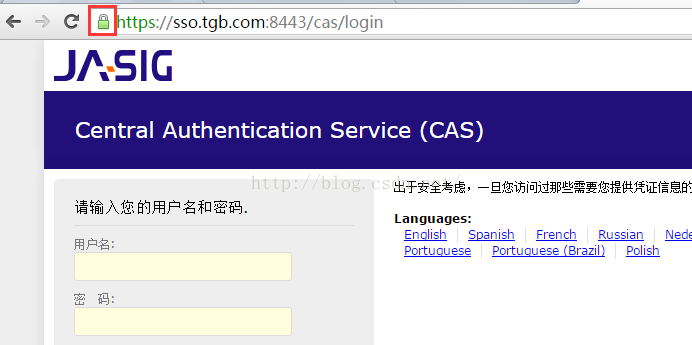文章16 | 阅读 6557 | 点赞0
轻松把玩HttpClient之配置ssl,采用绕过证书验证实现https
上篇文章说道httpclient不能直接访问https的资源,这次就来模拟一下环境,然后配置https测试一下。在前面的文章中,分享了一篇自己生成并在tomcat中配置ssl的文章《Tomcat配置SSL》,大家可以据此来在本地配置https。我已经配置好了,效果是这样滴:
可以看到已经信任该证书(显示浅绿色小锁),浏览器可以正常访问。现在我们用代码测试一下:
public static void main(String[] args) throws ParseException, IOException, KeyManagementException, NoSuchAlgorithmException, HttpProcessException {
String url = "https://sso.tgb.com:8443/cas/login";
String body = send(url, null, "utf-8");
System.out.println("交易响应结果:");
System.out.println(body);
System.out.println("-----------------------------------");
}发现抛出了异常,我知道的有两种方案(也许还有我不知道的方案),这里介绍第一种方案,也是用的比较多的方案——绕过证书验证。直接看代码吧:
/**
* 绕过验证
*
* @return
* @throws NoSuchAlgorithmException
* @throws KeyManagementException
*/
public static SSLContext createIgnoreVerifySSL() throws NoSuchAlgorithmException, KeyManagementException {
SSLContext sc = SSLContext.getInstance("SSLv3");
// 实现一个X509TrustManager接口,用于绕过验证,不用修改里面的方法
X509TrustManager trustManager = new X509TrustManager() {
@Override
public void checkClientTrusted(
java.security.cert.X509Certificate[] paramArrayOfX509Certificate,
String paramString) throws CertificateException {
}
@Override
public void checkServerTrusted(
java.security.cert.X509Certificate[] paramArrayOfX509Certificate,
String paramString) throws CertificateException {
}
@Override
public java.security.cert.X509Certificate[] getAcceptedIssuers() {
return null;
}
};
sc.init(null, new TrustManager[] { trustManager }, null);
return sc;
}然后修改原来的send方法:
/**
* 模拟请求
*
* @param url 资源地址
* @param map 参数列表
* @param encoding 编码
* @return
* @throws NoSuchAlgorithmException
* @throws KeyManagementException
* @throws IOException
* @throws ClientProtocolException
*/
public static String send(String url, Map<String,String> map,String encoding) throws KeyManagementException, NoSuchAlgorithmException, ClientProtocolException, IOException {
String body = "";
//采用绕过验证的方式处理https请求
SSLContext sslcontext = createIgnoreVerifySSL();
// 设置协议http和https对应的处理socket链接工厂的对象
Registry<ConnectionSocketFactory> socketFactoryRegistry = RegistryBuilder.<ConnectionSocketFactory>create()
.register("http", PlainConnectionSocketFactory.INSTANCE)
.register("https", new SSLConnectionSocketFactory(sslcontext))
.build();
PoolingHttpClientConnectionManager connManager = new PoolingHttpClientConnectionManager(socketFactoryRegistry);
HttpClients.custom().setConnectionManager(connManager);
//创建自定义的httpclient对象
CloseableHttpClient client = HttpClients.custom().setConnectionManager(connManager).build();
// CloseableHttpClient client = HttpClients.createDefault();
//创建post方式请求对象
HttpPost httpPost = new HttpPost(url);
//装填参数
List<NameValuePair> nvps = new ArrayList<NameValuePair>();
if(map!=null){
for (Entry<String, String> entry : map.entrySet()) {
nvps.add(new BasicNameValuePair(entry.getKey(), entry.getValue()));
}
}
//设置参数到请求对象中
httpPost.setEntity(new UrlEncodedFormEntity(nvps, encoding));
System.out.println("请求地址:"+url);
System.out.println("请求参数:"+nvps.toString());
//设置header信息
//指定报文头【Content-type】、【User-Agent】
httpPost.setHeader("Content-type", "application/x-www-form-urlencoded");
httpPost.setHeader("User-Agent", "Mozilla/4.0 (compatible; MSIE 5.0; Windows NT; DigExt)");
//执行请求操作,并拿到结果(同步阻塞)
CloseableHttpResponse response = client.execute(httpPost);
//获取结果实体
HttpEntity entity = response.getEntity();
if (entity != null) {
//按指定编码转换结果实体为String类型
body = EntityUtils.toString(entity, encoding);
}
EntityUtils.consume(entity);
//释放链接
response.close();
return body;
}现在再进行测试,发现果然通了。
下篇介绍另一种方案,应对自己生成的证书,敬请期待。
版权说明 : 本文为转载文章, 版权归原作者所有 版权申明
原文链接 : https://longxuan.blog.csdn.net/article/details/49865335
内容来源于网络,如有侵权,请联系作者删除!


